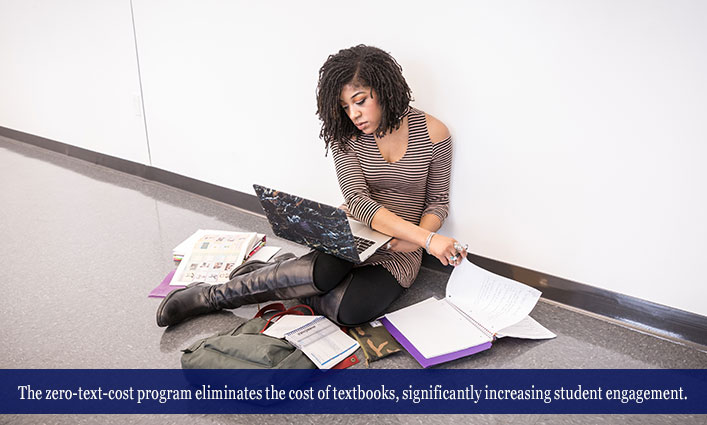
John Jay prides itself on giving all students, coming from any financial background, the opportunity to succeed. Understanding that the price of textbooks is a cost barrier for many students, some professors are opting to use the zero-text-cost program.
Through this program, CUNY allocated grant money is used to offer courses that utilize Open Educational Resources (OER) and licensed Alternative Educational Resources (AER) instead of traditional textbooks that students have to purchase. “There are students who can’t engage in the classroom because of textbook costs,” says Karen Argueta, a recent class of 2018 graduate and current student in John Jay’s Human Rights Master’s Program. “I’ve had classmates who took pictures of another student’s textbook, just to have the reading for the following week.” Using OER and AER materials like DVDs, eBooks, and streaming videos, which are all digitally available, boosts student engagement and increases student success. To learn more about the zero-text-cost program and its impact on students and professors, we spoke with Argueta, Dr. Raymond Patton, Director of Educational Partnerships and General Education; and Verlene Herrington, John Jay’s OER Librarian and Adjunct Associate Professor.
“There are students who can’t engage in the classroom because of textbook costs. I’ve had classmates who took pictures of another student’s textbook, just to have the reading for the following week.”—Karen Argueta (’18)
Q: The majority of John Jay students work at least one job and many students are coming from low-income families. What impact do you think zero-text-cost classes have on these students?
KA: The cost of textbooks is one of the student expenses that doesn’t get a lot of attention. I’ve had classmates who spend their printing money photocopying a textbook, only to find that they don’t have enough money to print a paper due that day. For many students there’s a genuine sigh of relief when it’s revealed that the course is zero-text-cost.
RP: It’s no secret that our students struggle to afford college. We know from surveys that many students take classes without buying the book, or they buy the book too late, do poorly or drop the course. Anything to ease this financial burden, allowing our students to focus on academics, is extremely helpful.
Q: How do professors teaching zero-text-cost courses feel about the materials they’re using?
RP: John Jay professors know that our students struggle to buy books and care deeply about this as an educational issue. Those who chose to create a zero-text-cost course were eager to have their students afford their education. Of course, this does come with a challenge. Textbooks provide the structure and content of a course, so redesigning it introduces some philosophical questions and practical challenges. This requires a substantial amount of time and effort to address.
VH: The professors are committed to help. The cost of textbooks has increased to three times the rate of inflation. This is much faster than the real estate and healthcare industry. Anything that professors can do to help students with this cost, they are willing to do.
“It’s no secret that our students struggle to afford college. We know from surveys that many students take classes without buying the book, or they buy the book too late, do poorly or drop the course.” —Dr. Raymond Patton
Q: Why do the new materials give professors more flexibility in comparison with regular textbooks?
RP: The typical textbook provides structure and content to a course—some even come with assignments, tests, and quizzes. However, in my experience as a History professor, the standard survey textbooks seemed to be designed with a traditional approach in mind. I was much more interested in cultivating critical reading, thinking, and expression skills, and in engaging how memory of the past is intertwined with our understanding of the present. Textbooks are simply not designed to support what I want to do with my courses.
VH: Learning outcomes for a course should drive the instructions, not a commercial textbook. Sometimes even a free OER textbook does not entirely address the learning outcomes. I tell faculty that they may need chapters from several OER textbooks, supplemented with library resources, like e-books, journal articles and videos to create the new material.
Q: Are there any “downsides” or “pitfalls” students should be aware of when using these new “zero-text-cost” materials?
RP: Most courses redesigned as zero-text-cost use a lot of digital materials, which brings up the challenge of guiding students to become digitally literate. Engaging with and annotating a hard copy written text is an unfamiliar experience for many students, and doing so with a digital text can be even more daunting.
Q: With technology affecting every industry in the world, do you see this type of classroom learning being the future?
RP: Many textbooks are digital already, and the library reports that students use digital materials more frequently than printed copies. We know the professional world demands digital literacy. Our challenge is preparing students to critically engage with the digitalizing world. Textbooks are a “textbook case” of planned obsolescence, with new editions supplanting the previous ones as often as publishers deem possible.



